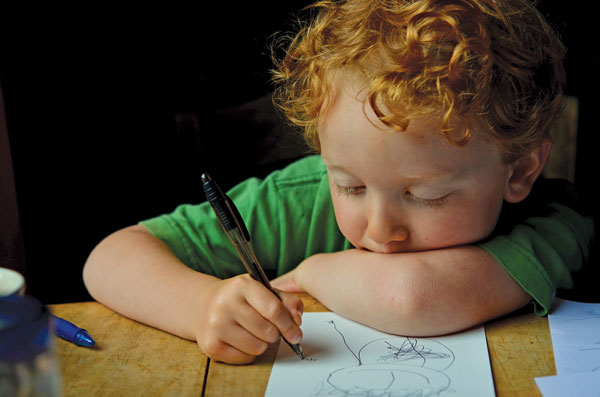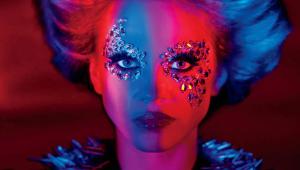Your Child In Pictures: The Parents’ Guide To Photographing Your Toddler And Child From Age One To Ten
Through 40 easy “photo recipes”—all organized by age, explained simply in Me Ra’s warm and inviting voice, and paired with adorable photo examples—Your Child in Pictures not only helps parents take better photos, but inspires them to discover photography as a way to connect with, cherish, and celebrate their children. Each photo recipe includes a simple explanation of how to set up and take the photo—with specific camera settings for both point-and-shoots and DSLRs—along with an inspiring photo example taken by either Me Ra or one of the many amateur photographer moms who have taken her workshops. (Liner notes supplied by publisher. Editor’s note: Grandparents could also benefit from this book!)

Young Artist
Your child works so hard on every drawing and is so excited to give each one to you. Why not capture him in the act? At this age, you may feel like he will always have a crayon or marker in hand. (After all, isn’t your refrigerator absolutely covered with his creations?) But for most, this stage of childhood will be fleeting, too, when you look back on it. Shirley Lange, a former CONFIDENCE Workshop attendee in Washington State, captured this precious moment of her grandson on a quiet afternoon.
When: Any time your child is in a quiet, artistic mood and soft light is coming in through a window or door.
Prep: Set your child’s desk or table facing a window so that you have as much natural light as possible. Feel free to arrange the table before he sits down to color. You want the story of this photo to be clear and full of coloring accessories (white paper, scissors, markers, and so on). Allow space and time for your child to become absorbed by his imagination.
For Point-and-Shoot Users: Turn off the flash. Set your camera to Aperture Priority mode so that the focus stays on your child. You don’t need Continuous Shooting mode if your child is still, but it’s always good to enable the mode in case he begins to move around.
For DSLR Users: Turn your flash off. Set your camera to Spot Metering mode and Aperture Priority shooting mode. Dial your f-stop down to f/4 or lower to capture the most light. Take the photo. Is your child too dark or too bright? Make a note of the shutter speed that your camera chose. Now switch your camera to Manual mode, and pick either a slower or a faster shutter speed than what your camera chose (depending on whether you need more or less light in the photo). If the lighting isn’t so bright, consider supplementing with a table lamp or increasing your ISO to 400.
Compose: Stand back and zoom in so that you don’t distract your child and lose the quiet moment. A horizontal format will work best, as it will allow you to capture both your child’s face and his work of art. Keep the Rule of Thirds in mind and frame your child’s head slightly off-center.
Capture: When capturing your child drawing, you can take a few different approaches. You can always focus on his eyes. But you can also get in front of him and focus on his hands while letting his face be blurred in the background. Give yourself freedom to play around with different viewpoints and focus points.
DSLR Settings: The aperture was set to f/4, which is slightly high. (Shirley was standing very close to her grandson, which allowed the background to be blurred.) The shutter speed was 1/100 sec (100), and ISO was set to 200 for best color saturation.

I Love To Dance!
Some of my most precious memories of Pascaline being three years old were when I would catch her dancing in a room by herself. She didn’t need music to twirl her dress, skip, and sway her arms. A child’s fearless innocence, uninhibited and free to dance, is an inspiring story to capture. For this photo recipe, DSLR users will have to shoot in Manual mode, but never fear, we will take it one step at a time.
When: The drama in this photo is enhanced by the lighting. Observe the morning and evening sunlight throughout your home. When does it come spilling through your windows and/or glass doors? That’s when you want to take your photo.
Prep: Dress up your little one in clothing that light can shine through, and have her stand in front of the window or door. Turn off all the lights in the room. The contrast between the bright outdoor light and dark interior will enhance the drama in your photo’s story.
For Point-and-Shoot Users: This photo is difficult to capture with a point-and-shoot, but you can get close by doing the following steps: Turn your flash off, and set your camera to Continuous Shooting mode. Select Portrait mode. Focus on your subject. If she becomes dark (due to the bright background), touch your subject on the LCD display screen. Many smartphones and compact cameras now have a touch-screen feature that enables you to brighten the area you touch to avoid a silhouette.
For DSLR Users: First, turn off your flash, and set your camera to Continuous Shooting mode. Next, set your camera to Aperture Priority mode, and take the photo. If your photo is a silhouette, your shutter curtain is opening and closing too fast. It’s okay. Write down the shutter speed that your camera chose. Now switch to Manual mode. You need to slow your shutter speed down to let more light in, so roll your shutter speed dial a few clicks to the left. Take another photo. Keep adjusting the dial until you have enough light.
Compose: If your background is a glass door, like mine, a vertical format will allow you to capture the full height of the door. If you are taking a photo of your child in front of a bay window, a horizontal format may be more flattering. Have fun experimenting, depending on the type of dancing your child is doing and the room you are in.
Capture: Focus on your child’s face. If you don’t want your child’s face in the center, hold your shutter button halfway down, and then reframe the image so that your child is off-center and take the photo.
My DSLR Settings: My aperture was low, f/2.8, to soften the background. The ISO was 400 for good color saturation and also capturing movement. The shutter speed was 1/1000 sec to freeze the moment with sharpness.

About The Author
Me Ra Koh, nationally recognized as “The Photo Mom,” is host of the Disney Junior TV show Capture Your Story with Me Ra Koh, and the former guest photography expert on The Nate Berkus Show (NBC). She also writes a weekly column for Disney’s Babble.com, A Focused Life. She is a Sony Artisan of Imagery, and her work and photo recipes have been featured on The Oprah Winfrey Show, Lifetime Television, VH1, Sesame Street, and Martha Stewart Living Radio, as well as in the New York Times, Parenting, American Baby, Popular Photography, American Photo and most recently exhibited in The Museum of Natural History in NYC. She is a sought-after guest on national television, magazines, podcasts and blogs for her in-depth knowledge and insight, as well as her authenticity, unique charisma and dedication to empower moms. She is the bestselling author of Your Baby in Pictures: The New Parents’ Guide to Photographing Your Baby’s First Year and newly released, Your Child in Pictures: The Parents’ Guide to Photographing Your Toddler and Child from Age One to Ten (Amphoto Books). Along with her husband, Brian, they lead a nationwide team of Me Ra Koh Workshop Teachers who are both professional women photographers and ambassadors of the Me Ra Koh brand, carrying the mission to infuse confidence in moms with a camera. She has put together strategic visual storytelling campaigns with corporate partners; Disney, Sony, Sesame Street, Southwest Airlines, Nielsen and more. She is a popular keynote speaker and has a deep passion for homeschool and traveling abroad with her husband and family. You can find her online at www.merakoh.com.
Choosing Clothes That Glow
Capturing light as it shines through sheer fabrics can add an element of pure magic to your photos. Many kinds of lightweight outfits or accessories will achieve this effect—from gauzy princess dresses to shimmering superhero capes. When clothes shopping, be on the lookout for dresses and capes that are simple in design but sheer in texture. (You can even invite Grandma to help you on this wardrobe photo challenge!)

Where To Buy
Your Child in Pictures: The Parents’ Guide to Photographing Your Toddler and Child from Age One to Ten (Amphoto Books, $19.99, ISBN: 978-0-8230-8618-4) is available in bookstores and online.

















































